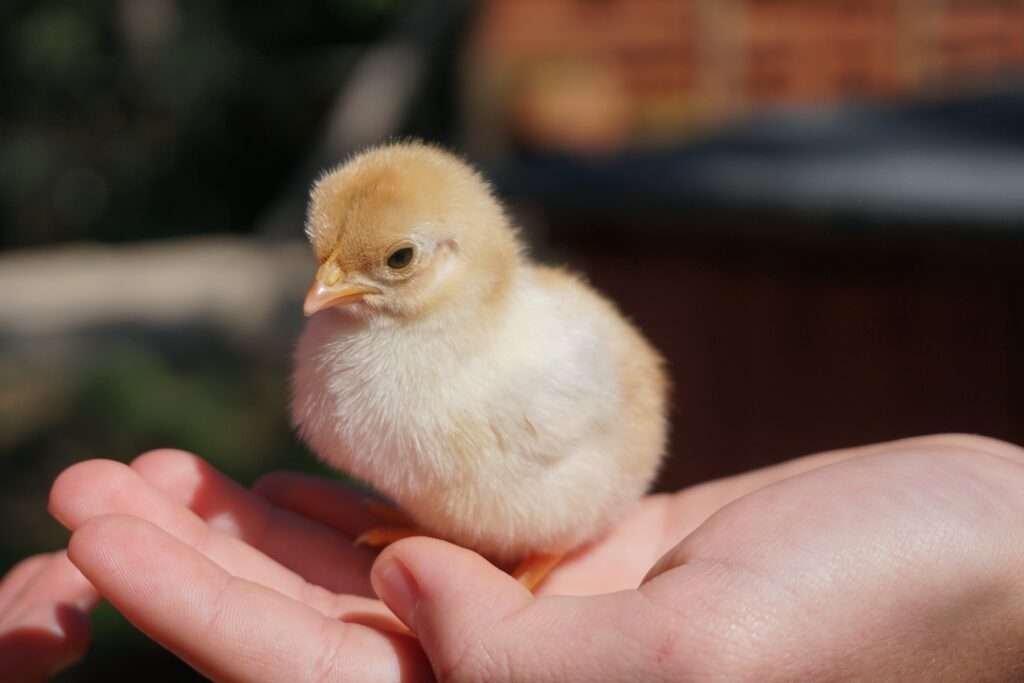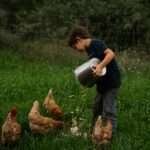Raising chickens can be an enriching experience for both adults and children alike. The joy of collecting fresh eggs, nurturing adorable chicks, and watching these feathered friends explore the yard is a rewarding adventure. As parents and caregivers, it’s our responsibility to not only care for these creatures but also to teach the younger generation how to interact with them safely and compassionately. In this guide, we’ll delve into the art of teaching kids how to pick up a chicken, ensuring that the experience is not only fun but also respectful of the animals’ well-being.
Understanding Chickens’ Behavior and Body Language
Chickens are fascinating creatures with their own unique behaviors and ways of communicating. Before embarking on the journey of teaching children to handle them, it’s essential to grasp the basics of chicken behavior. Understanding how chickens express themselves can help kids interpret their feelings and reactions accurately, fostering a deeper connection between the child and the bird.
Chickens communicate through a variety of gestures, vocalizations, and postures. When chickens are comfortable and content, they display relaxed body language. This includes standing upright with their feathers neatly arranged and their eyes open. They might peck at the ground, scratch for food, or take short dust baths to keep themselves clean. These behaviors indicate that the chickens are at ease in their environment.
On the other hand, chickens can show signs of distress or discomfort through their body language. If a chicken feels threatened or frightened, it may exhibit behaviors such as fluffing up its feathers to appear larger, crouching low to the ground, or tucking its head under its wing. These behaviors are their way of trying to protect themselves from potential danger.
Preparation Before Teaching Kids How To Pick Up a Chicken
Before embarking on the adventure of teaching kids how to handle chickens, it’s important to lay the groundwork for a positive and respectful experience. Proper preparation not only ensures the chickens’ well-being but also sets the stage for a successful learning process.
One crucial aspect is cleanliness. Before and after handling chickens, it’s vital for both children and adults to wash their hands thoroughly. This not only prevents the potential spread of disease but also teaches kids the importance of good hygiene and animal care.
Creating a designated chicken handling area is another essential step. This area can be a small fenced section of the yard or a spot within the chicken coop. The goal is to minimize stress for the chickens by providing them with a predictable environment. By consistently using this area for interactions, chickens will become more accustomed to human presence and handling, which leads to less stress for both parties involved.
Practice with a stuffed teddy or a ball is a great way to demonstrate the holding technique and have the children master this before a live animal. Placing the teddy on the ground and having the children approach, pickup and hold means you have opportunities to adjust their technique before all the excitement of feathers occurs.
The Role of Adult Supervision
While empowering kids to learn and explore independently is valuable, adult supervision is crucial when teaching children how to handle chickens. An adult can provide guidance, offer reassurance, and step in if any unexpected situations arise. Furthermore, having an adult present helps create a safe environment for both the child and the chicken.
In the next section, we’ll delve into the proper techniques for picking up and holding chickens. By following these steps, children can confidently and gently interact with these charming birds, nurturing a sense of responsibility and empathy that will stay with them for a lifetime.

Proper Technique for Teaching Kids How to Pick Up a Chicken
Teaching kids how to pick up and hold chickens involves a delicate balance between ensuring the safety and comfort of the bird and empowering the child to handle the experience with confidence. By following these steps, children can learn to approach, pick up, and hold chickens in a way that minimizes stress and promotes a positive interaction.
Approach with Care
When introducing children to the process of picking up a chicken, it’s essential to emphasize the importance of a calm and gentle approach. Chickens can be easily startled by sudden movements or loud noises, so encourage kids to approach slowly and quietly. Explain to them that a relaxed approach helps the chicken feel more at ease and less likely to become distressed.
Encourage kids to approach the chicken from the front rather than from behind. This allows the chicken to see them coming, reducing the chances of surprise and fear. Remind children to speak softly to the chicken as they approach, using soothing tones to convey their intentions.
Secure and Gentle Hold
Teaching children how to properly hold a chicken involves showing them the right techniques for hand placement and support. Explain that using both hands is crucial for a secure and comfortable grip. One hand should be placed under the chicken’s wings, supporting its body, while the other hand gently holds its legs. This balanced grip prevents the chicken from feeling unstable or squeezed.
Guide kids on how to position their hands to avoid putting too much pressure on the chicken’s body or wings. The goal is to hold the chicken gently but firmly enough that it doesn’t feel like it’s slipping away. Encourage them to use their fingers to cradle the chicken’s body gently without gripping too tightly.
Lifting and Positioning
Once the child has a proper grip on the chicken, it’s time to lift it off the ground. Instruct kids to lift the chicken smoothly and steadily, keeping it close to their body. This minimizes any jarring movements that could startle the bird.
While holding the chicken, advise kids to position it against their chest. This closeness provides a sense of security for the chicken, as it can feel the child’s body warmth and hear their heartbeat. Explain that this feeling of security reduces stress for the bird and makes the experience more comfortable overall.
Comfortable Positioning
As the child holds the chicken, guide them on how to position the chicken’s legs. Chickens naturally feel more secure when their legs are supported and not left dangling. Encourage kids to gently tuck the chicken’s legs against their own body or forearm, ensuring that the chicken feels stable and balanced.
Additionally, remind children to hold the chicken against their bodies rather than extending their arms fully. This not only provides a cozy spot for the bird but also prevents the chicken from flapping its wings excessively, which can lead to stress and discomfort.
Observing the Chicken’s Response
While holding the chicken, encourage kids to observe its behavior closely. A calm and content chicken will exhibit signs such as relaxed feathers, alert eyes, and minimal movement. On the other hand, if the chicken appears anxious, such as struggling to escape or making distress calls, it’s a sign that it might be uncomfortable.
Teach children that their role as caregivers includes recognizing the chicken’s feelings and responding appropriately. If the chicken seems agitated, it’s best to gently place it back in its designated area and give it some space. This practice reinforces empathy and respect for the bird’s well-being, teaching kids to prioritize the comfort of their feathered friends.
By mastering these techniques, children can develop a strong foundation for interacting with chickens in a way that fosters trust and a positive relationship.

Tips for Teaching Kids
Instilling a sense of responsibility and empathy in children while teaching them to handle chickens is a rewarding endeavor. To make the learning experience engaging and effective, consider implementing these tips when teaching kids how to pick up and hold chickens.
1. Storytelling Approach Children often connect well with stories. Use a storytelling approach to explain the process of picking up and holding chickens. Use a story from when you were a child or make one up to demonstrate a key learning. This not only educates children but also captures their imagination and makes the learning process enjoyable.
2. Relatable Analogies Use relatable analogies to help children understand the concepts better. For instance, explain that picking up a chicken is similar to hugging a teddy bear gently. This analogy helps kids visualize the right level of softness and care needed when handling a delicate creature.
3. Practice with Stuffed Animals Before handling real chickens, encourage children to practice with stuffed animals. This allows them to get comfortable with the idea of holding something gently and supporting its weight. Gradually, they can transition from stuffed animals to real chickens, building their confidence along the way.
4. Role Modeling Children often learn by imitating adults. Demonstrate the proper techniques for picking up and holding a chicken, and then let them mimic your actions. This hands-on learning approach helps kids feel more comfortable and capable when it’s their turn to handle a chicken.
5. Positive Reinforcement Offer positive reinforcement and praise throughout the learning process. Celebrate each successful attempt at gently holding a chicken. This positive feedback boosts children’s confidence and encourages them to continue practicing respectful chicken handling.
Handling Different Ages and Personalities
Adapting your teaching approach to the child’s age and personality is essential for effective learning. Here are some guidelines for teaching kids of different ages and temperaments:
1. Younger Children (Ages 4-7)
- Keep instructions simple and concise.
- Use colorful visuals or drawings to illustrate key points.
- Provide hands-on guidance while they handle the chicken.
- Encourage them to ask questions and express their feelings.
2. Older Children (Ages 8-12)
- Offer more detailed explanations about chicken behavior.
- Allow them to take more independent steps while handling chickens.
- Encourage critical thinking by asking questions like, “Why do you think the chicken is calm?”
- Discuss the importance of responsibility and empathy.
3. Apprehensive Children
- Start by observing chickens from a distance to build familiarity.
- Gradually introduce hands-on experiences, beginning with observing an adult handle a chicken.
- Offer gentle encouragement and reassure them that it’s okay to take their time.
- Focus on the positive aspects of chicken handling, such as the joy of bonding with a gentle creature.
Building a Positive Connection
Teaching kids how to pick up and hold chickens goes beyond the physical act; it’s about building a positive connection between the child and the bird. This connection fosters empathy, responsibility, and a deep appreciation for the natural world. As children learn to handle chickens with care, they’re also learning important life lessons about empathy, respect, and nurturing.
Teaching Kids How to Pick Up a Chicken
Teaching kids how to pick up and hold chickens is a valuable lesson that extends far beyond the realm of poultry care. By understanding chicken behavior, following proper techniques, and tailoring the teaching approach to the child’s age and personality, you’re imparting important life skills that promote empathy and responsibility. Through gentle interactions with these delightful creatures, children can develop a lifelong appreciation for animals and nature, nurturing a connection that enriches their lives and the world around them.





